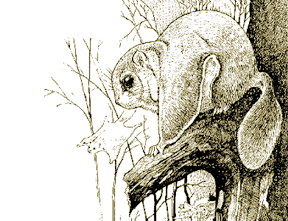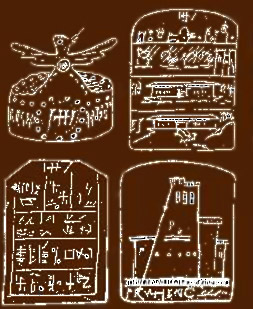STORY LINKS
Front Page
Wright is Wrong
Mystery Airship
Killer Cougars
Giant Rabbits
Michigan Caves?
Islands from Space!
Flying Squirrels
Bogus Archeology
Gold in the River!
Michigan's Cactus
Foolish Fire
Pileated Woodpecker
Questions, comments, submissions, & advertising
Contact BPP
|

 Michigan Chronoscope - Stories on the fringe of history
Michigan Chronoscope - Stories on the fringe of history
Chronograph Numeral I - Autumn 2004 - Page Five
|
Michigan's Flying Squirrels
 Northern Flying Squirrel (Glaucomys sabrinus)
Northern Flying Squirrel (Glaucomys sabrinus)
I had always heard that we had flying squirrels here in Michigan but I never quite believed it until I lived in the woods. After being in the woods for a few years I saw one close-up and examined it quite thoroughly. You see, the critter was dead on the lawn, the apparent victim of one of our house cats. At first, I couldn't tell what kind of critter it was until I noticed the skin flaps along the sides of its body that it uses to glide with. I realized it was a flying squirrel and wondered why I hadn't seen any gliding from tree to tree. The cats must have seen them, why hadn't I?
After a short but morbid re-enactment of a Rocky & Bullwinkle episode, I decided to learn more about them. What I found explains why I hadn't been seeing them, they are nocturnal and I wasn't out nature-watching at night. I also learned that most of the flying squirrels found on the planet come from Asia. In our hemisphere, we have only two kinds with some local varieties. Those two kinds are the southern flying squirrel (Glaucomys volans) and the northern flying squirrel (Glaucomys sabrinus), both of which are native to Michigan.
The northern flying squirrel lives in the U.P. and northern Lower Peninsula, while the southern flying squirrel lives in the southern half of the Lower Peninsula. Although the northern ones are larger than the southern ones, they are being out-competed by their southern cousins. Evidence suggests that the existence of the northern flying squirrel in the Lower Peninsula is at risk. Two Appalachian subspecies of the northern flying squirrel are on the federal endangered species list. The Carolina northern flying squirrel is classified as endangered in North Carolina and Tennessee, and the Virginia northern flying squirrel is classified as endangered in Virginia and West Virginia.
I'm fairly certain the one I saw was one of the southern kind. The southern flying squirrel is smaller and grayer, with a white underbelly. When the two types of squirrels live together, the Southerners like hardwoods, and the Northerners like the pines. Both have similar habits like nesting in hollow trees, but there are important differences between the two.
The Northern Flying Squirrel feeds primarily on lichens and subterranean fungi but also eats various nuts, seeds, and insects. The northern squirrel, unlike the southern, doesn't hibernate and is active throughout the year. Also, they have only one litter per year, unlike the southern flying squirrel, which sometimes has two. Outside of my cats, owls are the flying squirrel's main predators..
Although it would be hard to see them at night flying squirrels often visit bird feeders. One way to view them after dark is to use a red light (which doesn't bother them) on the feeder. One way to find them during the day is to tap on dead trees with woodpecker holes and they will peek out and scamper or glide away if they're in there.
Comment about this article on the
Epress Forum Board
.

|
|
|
Local Connection to Bogus Archeology
 Phoney Finds
Phoney Finds
In the late 1800s, there was great interest in old artifacts and ancient antiquities. It was during this early era of archeology that many people became interested in the objects and stylizations of art produced by past civilizations. Mummies and Egyptian artifacts were featured in traveling shows. Collections of American Indian crafts like baskets, beadwork, and blankets were becoming fashionable. Because they could not translate ancient languages like Egyptian and their hieroglyphs, people speculated about the nature of the objects and the meaning of their writings. Having little to go on they relied heavily upon The Bible's historical accounts to explain some of the strange and utterly foreign artifacts uncovered in the Americas. Although many honest men had good intentions when they tried to explain such relics by making biblical connections, there were those whose intentions were equally dishonest. Such men were behind a scam here in Michigan that involved creating bogus artifacts and bogus stories backing them up.
For around 20 years, from 1890 to 1911, a con artist duo from Detroit (where else!) had a scheme, a way to make easy money from innocent marks, they created fake artifacts and sold them as real antiquities. Those confidence men were James O. Scotford and Daniel E. Soper and they were undoubtedly some kind of memorable characters. Mr. Scotford, originally from Edmore, was a sleight-of-hand performer using the profession of sign painter as a front and Daniel Soper was once secretary of state but resigned after demanding kickbacks from his deputy's salary. The two met while living near to each other in Detroit and hatched an idea to make some big money. They would create fake artifacts with hieroglyphic-like drawings depicting scenes from the bible and then they would dig them up in front of prominent citizens for them to act as witnesses.
They pulled off the scam at Indian mounds sites that were found around the Detroit area. Eventually they brought the scam closer to Scotford's hometown and dug up artifacts in Montcalm County. Many people scoffed at such finds as fraudulent, but enough believed to pay money for them as real artifacts. Father James Savage of Most Holy Trinity Church in Detroit bought Indian and Biblical relics hoping they were real. Even professionals were duped, like one Professor Kinnaman of Benton Harbor, who was quoted as saying that Soper's artifacts "will compel archaeologists to revise their theories of the origin and development of all civilization as it exists today." Scotford and Soper's con even had many people believing that Noah's ark landed here in Michigan!
Eventually, experts from the Detroit Institute of Arts, University of Michigan, University of Chicago, and even the Smithsonian Institution declared them fakes and frauds. It wasn't until the Detroit News exposed them before they stopped selling their bogus artifacts. Soper defended his finds and no charges were ever filed but The Detroit News' story made it hard for Soper and Scotford to do business, so they went on to other things. In some ways, little has changed in the past one hundred years. Archeologists still have certain beliefs and often impose their beliefs upon their findings to the exclusion of other possibilities.
Comment about this article on the
Epress Forum Board
.
|
|
Keywords: Michigan, Great Lakes, history, amazing, astonishing, baffling, bizarre, cryptic, curious, different, extraordinary, forgotten, hidden, incredible, inexplicable, legends, lore, lost, myths, obscure, odd, peculiar, rare, stories, strange, surprising, tales, unexplained, unfamiliar, unique, unknown, unusual, weird
|
|



